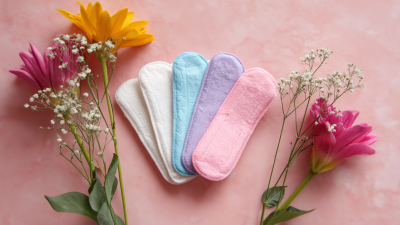
The Unsung Benefits of Plastic Free Sanitary Pads and Their Positive Impact on Women's Health and the Environment
In recent years, the conversation around menstrual health and hygiene has evolved significantly, highlighting the importance of sustainable practices. Plastic Free Sanitary Pads have emerged as a revolutionary alternative that not only supports women's health but also benefits the environment. According to a report by The World Health Organization, approximately 1.8 billion women menstruate globally, with traditional sanitary products contributing to vast amounts of plastic waste each year—estimated to reach 150 billion pads and tampons discarded annually. In contrast, studies indicate that plastic-free options can reduce carbon footprints significantly, with some brands claiming a 50% reduction in greenhouse gas emissions compared to conventional products. Furthermore, by eliminating harmful toxins found in plastic-based pads, these sustainable alternatives promote better health outcomes for users, thus addressing both ecological and personal well-being. This article will explore the numerous benefits of transitioning to Plastic Free Sanitary Pads, encouraging a shift that could lead to profound societal change.

The Environmental Advantages of Plastic-Free Sanitary Pads
Plastic-free sanitary pads offer significant environmental advantages, particularly in the context of reducing plastic pollution, which poses a serious threat to both human health and ecosystems. Many conventional sanitary products contain polyethylene, contributing to the persistent plastic waste in landfills and oceans. By switching to plastic-free options, we can drastically reduce this waste. For instance, innovative alternatives, such as those made from cornstarch, have shown promising results in cutting down millions of pounds of plastic waste annually.
Tips: When selecting menstrual products, consider eco-friendly materials and brands that prioritize sustainability. Look for certifications that ensure your choice supports both women’s health and environmental well-being. Additionally, researching local initiatives that promote menstrual health can provide insight into community efforts aimed at addressing period poverty and promoting sustainable practices.
Menstrual health is an increasingly important aspect of reproductive and maternal health strategies globally. The promotion of plastic-free sanitary pads aligns not only with environmental objectives but also fosters a healthier relationship between women and their bodies. Sustainable options, like menstrual cups and reusable pads, mitigate environmental impact while providing economic benefits in the long run, ultimately empowering women to make informed choices about their health and the planet.
Understanding the Health Benefits of Using Plastic-Free Sanitary Products
The increasing awareness of microplastics and their presence in human health has sparked a significant shift towards plastic-free sanitary products. According to forecasts, the global personal care market is expected to grow from $181.77 billion in 2025 to $263.10 billion by 2032, with a compound annual growth rate of 5.44%. This growth reflects not only the demand for innovative products but also the growing consciousness about the environmental impacts of plastic waste.
Research has shown alarming findings, including the detection of microplastics in human breast milk, highlighting a critical intersection between women's health and environmental sustainability. As more women opt for plastic-free sanitary pads, they contribute to a reduction in plastic pollution while promoting their well-being.
Embracing these products can mitigate the risk of exposure to harmful chemicals often found in traditional hygiene products, fostering both personal health and ecological balance. The rise of the “naked shopping” trend, characterized by minimal packaging and eco-friendly choices, further emphasizes the commitment to more sustainable living, paving the way for a healthier future for women and the planet alike.
Cost-Effectiveness: Analyzing the Economic Impact of Sustainable Sanitary Pads
The shift towards plastic-free sanitary pads is not only beneficial for women's health and the environment but also offers significant economic advantages. A recent report by the International Journal of Environmental Research and Public Health indicates that conventional sanitary products, often made with synthetic materials, can cost users up to $6,000 over their reproductive years. In contrast, opting for sustainable alternatives, such as organic cotton or reusable pads, can substantially reduce this financial burden, with estimates suggesting that women could save up to 70% on their menstrual hygiene costs.

Moreover, the production of plastic-free sanitary pads often involves local sourcing and ethical labor practices, which not only supports local economies but also helps in reducing the overall carbon footprint associated with menstrual products. A study from the Ellen MacArthur Foundation highlights that if just 25% of women switched to sustainable pads, it could save approximately 6.5 million tons of carbon emissions annually. This economic perspective highlights a dual benefit: savings for consumers and positive contributions to environmental sustainability, ultimately fostering a healthier planet and empowering women's financial independence.
How Plastic-Free Sanitary Pads Promote Sustainable Waste Management
Plastic-free sanitary pads are a sustainable choice that significantly reduces environmental impact while promoting women's health. Traditional pads often contain harmful plastics that contribute to landfill overflow and pollution, taking hundreds of years to decompose. In contrast, plastic-free alternatives, made from organic cotton or bamboo, break down naturally, ensuring a healthier planet for future generations. This shift not only helps manage waste more sustainably but also reduces exposure to harmful chemicals often found in plastic products.

Tips for Transitioning to Plastic-Free Sanitary Pads:
1. Start small by trying out different brands to see which materials work best for you and your body.
2. Keep a reusable cloth bag or pouch handy for carrying your sanitary items, making it easy to manage waste during outings.
3. Educate yourself about the lifecycle of sanitary products and share your knowledge, helping to foster a community focused on sustainable practices.
By choosing plastic-free sanitary pads, women can take a proactive step towards better personal health and an eco-friendlier lifestyle, showcasing how individual choices can lead to a larger positive impact on our environment.
Consumer Awareness: The Shift Towards Eco-Friendly Menstrual Products
The shift towards eco-friendly menstrual products is gaining traction as consumer awareness grows about sustainability and its health benefits. Recent reports suggest that approximately 9.7% of consumers are willing to pay a premium for sustainably sourced products, even amid rising costs of living. This trend is particularly evident in the feminine hygiene market, which is projected to continue its upward trajectory as more women seek alternatives to traditional products, including plastic-free sanitary pads. As concerns regarding plastic pollution and women's health come to the forefront, brands that prioritize eco-friendly materials are seeing increased interest and sales.
Additionally, the period panties market is also experiencing transformative growth, with projections indicating an 18.4% CAGR from 2025 to 2035. This surge is fueled by consumer demand for sustainable options that prioritize both comfort and environmental responsibility. The emphasis on organic and eco-friendly personal care products reflects a broader trend towards conscientious consumption, as individuals increasingly recognize the impact of their purchasing decisions on both personal health and the planet. As sustainability becomes a central focus in consumer choice, the use of plastic-free sanitary pads is poised to make a significant positive impact on women's health and the environment.
The Unsung Benefits of Plastic Free Sanitary Pads and Their Positive Impact on Women's Health and the Environment
| Benefit | Impact on Women's Health | Environmental Impact | Consumer Awareness Level |
|---|---|---|---|
| Biodegradability | Reduced risk of allergic reactions | Breaks down naturally, less landfill waste | Growing awareness of eco-friendly products |
| Chemical-Free Materials | Lower chemical exposure | Reduced pollution from production | Increase in consumer preference for natural products |
| Comfort | Better breathability, fewer irritations | Less plastic waste entering ecosystems | Heightened interest due to health campaigns |
| Reusable Options | Cost-effective over time | Significant reduction in waste generation | Growing community support for sustainable practices |
| Support Local Economies | Empowerment through local production | Lower carbon footprint from transportation | Increased advocacy for social responsibility |
Related Posts
-

How to Choose the Best Plastic Free Sanitary Pads for Your Eco Friendly Lifestyle
-

How to Choose the Best Plastic Free Sanitary Pads for Sustainable Living
-

Innovative Solutions for Eco-Friendly Menstrual Care: Best Washing Reusable Sanitary Pads Fiber
-

7 Facts About Best Sustainable Sanitary Pads That Every Global Buyer Should Know
-

5 Essential Menstrual Materials You Didn't Know You Needed for Ultimate Comfort
-

Ultimate Checklist for Choosing Sustainable Sanitary Pads: Key Considerations and Statistics



